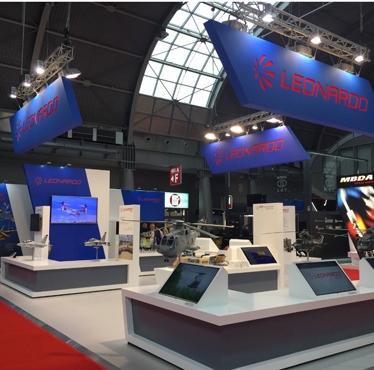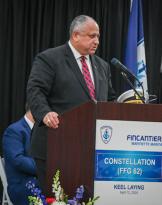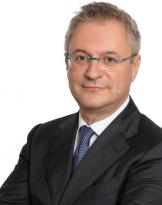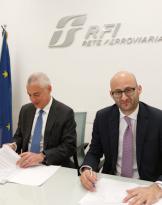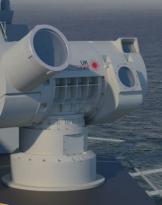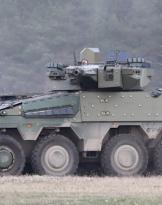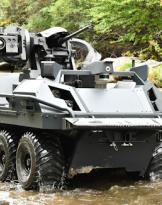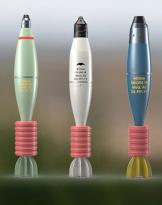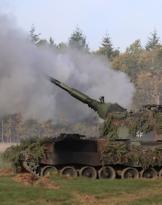Leonardo-Finmeccanica takes part in MSPO 2016 (6-9 September), one of the most important defense trade shows in Europe and held in Kielce, Poland. The company attributes great strategic importance to this country, with considerable investments made in recent years (in particular following the acquisition in 2010 of the Polish helicopter company PZL-Świdnik) and multiple opportunities offered both by the defense and security market and by the civil.
The Polish Air Force has ordered 8 Aermacchi M-346 along with its integrated training system and deliveries are expected to begin this November. The M-346 ITS (Integrated Training System) is a new generation advanced training system designed and built by Leonardo to allow pilots to transition easily and efficiently from the basic training phase to the latest generation advanced combat aircraft. The aircraft is part of a state-of-the-art and already extensively proven integrated system, comprising a wide range of educational systems and capable of taking a new student step by step to become an M-346 pilot. The aircraft is equipped with advanced avionics and human-machine interface systems, developed in collaboration with Leonardo Avionics and Space Systems, and with an advanced ETTS (Embedded Tactical Training System) that allows to carry out mission training for air-to-air and air-to-surface tasks without the use of real opponents but using computer-generated "threats" with the use of radar and simulated weapon systems (either in stand-alone mode or in more complex scenarios with the involvement of other M-346s connected via Data-Link).
The M-346 is not just an excellent advanced trainer. In the role of 'aggressor' this aircraft has already obtained a validation at NATO level in joint exercises in Albacete and by the Italian Air Force in national operations against Eurofighter and AMX. The M-346 ITS also includes the first fully operational Live-Virtual-Constructive system in an Air Force that allows one or more M-346s to be connected in flight and perform a joint mission with one or more pilots in the flight simulator. ground mission. The pilot in the simulator can see real aircraft in the simulator's vision system while the pilot on board can see ground-based and simulator-based M-346s through the ETTS radar and on the helmet display. Using the real-time monitoring station, the instructor will be able to monitor the entire exercise and can change the tactical situation by adding new virtual targets, a virtual tanker and so on.
The new version Fighter Trainer (FT) is an M-346 capable of dual-role modes to perform both advanced training and air-to-air and air-to-surface missions, thanks to the integration of guided and unguided bombs, rockets, air-to-air missiles, and installation of a Radar Warning Receiver (RWR), a Chaff & Flare deception dispenser, a display mounted on the pilot's helmet and a reconnaissance pod. Weapons and systems integration tests have already begun. It is expected to enter service in 2018. The M-346 Fighter Trainer is the result of a company-funded development, based on solid market potential for a multi-role version of the highly regarded M-346 Advanced Trainer. the world.
Several other air forces are paying close attention to this option, which allows this high performance trainer to play the role of an effective light combat aircraft.
Leonardo participates in MSPO 2016 highlighting its leadership in the helicopter field and, in Poland, through PZL-Świdnik, acquired in the 2010.
Celebrating the 3300th anniversary of the start of helicopter production this year, PZL-Świdnik is the only Polish-designed rotary-wing aircraft manufacturer capable of R&D, system integration, construction, support and training, aircraft modernization. Thanks to PZL-Świdnik, Poland is one of the five European countries that can boast the ability to design, manufacture, develop and maintain its own helicopters. Currently 650 employees are employed at PZL-Świdnik, including 1000 engineers, and cooperates with nearly 4500 Polish companies, generating nearly 7400 additional jobs in the country's economy. Most of its partners are based in the southeastern part of the country, including members of the largest Polish aviation district, called Aviation Valley, and the Lublin Advanced Aerospace Technology District. PZL-Świdnik is one of the largest employers and taxpayers in the Lublin region and has produced and delivered more than 40 helicopters to date to customers in over 160 countries around the world. PZL-Świdnik is a key partner of the Polish Ministry of Defense as a key component of the main helicopter programs of the Polish Armed Forces, which operate nearly 80 PZL-Świdnik helicopters. Almost 4% of the helicopters delivered to the Polish Armed Forces in recent decades have been made in Świdnik (SW-3 Puszczyk, W-3PL Głuszec, W-4WA Sokół in VIP version for the transport of institutional leaders). With the development and testing of the SW-XNUMX 'Solo' RUAS / OPH (remote control helicopter with the possibility of being able to operate also with a pilot on board), Leonardo also launched its first 'unmanned' helicopter.
Leonardo's helicopter statics at the show includes a W-3PL Głuszec it's a AW149 with a wide range of equipment and weapon systems underlining the versatility of current and future helicopter technology developed in Poland. The W-3PL Głuszec helicopter is the latest version of the Sokół, optimized for armed missions such as Combat Search and Rescue (CSAR), close support, transport of troops and materials, escort, surveillance and target acquisition, assault . The first four Głuszecs were handed over to the Polish Army in December 2010. Subsequently, a second contract was signed to bring a further four Sokół to the W-3PL standard. The AW149 is a new generation twin-engine military helicopter, the first in its class in the last 40 years. The AW149 provides the flexibility required of a modern helicopter deployed in the field and performs missions such as close support, troop and material transport, medical evacuation, SAR / CSAR, command and control and other tasks with unmatched levels of cost / effectiveness.
Electronics Terrestrial Defence and Naval
In the Defense and Security Electronics sector, Leonardo boasts consolidated relationships with Poland. In addition to the installation of three Fixed Air Defense Radar (FADR) radar systems for the Polish Air Force, the company has also supplied the ZSRN automated coastal surveillance system and has long been present in the country with its navigation and meteorological aid. More recently, as part of the BRASS (Broadcast and Ship to Shore) program, Leonardo was awarded a contract to equip the Polish Navy with NATO telecommunication systems.
MSPO represents an opportunity to continue promoting Leonardo's capabilities and solutions in the naval and land sectors, in particular for: combat systems, battlefield and electro-optics sensors, communication systems, fixed and mobile C4I solutions as well as integrated air defense systems to support customers in the export market.
In addition, the company aims to provide the Polish Armed Forces with cost-effective solutions for integrated logistic support to support its already installed systems, through partnerships with local companies and developing know-how and technology in the country.
There are a number of key opportunities, including: Naval programs of the Navy such as the "CZAPLA" for offshore patrol boats and the "MIECZNIK" for coastal defense and satellite communication systems for the Armed Forces (with the supply of the station of transmission and small and medium-sized satellite terminals).
More recently Leonardo has supplied the Polish Air Force with avionic equipment (including the load management system, the head-up-display, the flight control computer, V / UHF radio, IFF, etc.) for the program related to the Advanced Jet Trainer - AJT and a mission simulator. In addition, the company sold Multi Mode Receiver (MMR) receivers to Wojskowe Zakłady Lotnicze intended for installation on the Mig-29 and Su-22 aircraft of the Armed Force.
Among the business objectives of particular importance there are: UAV programs in different classes (MALE, Tactical, MINI and MICRO); avionics equipment, sensors (EW / radar) and simulators for the AJT program; a training center for UAS for the Polish Air Force; possible trilateral agreements (Germany, Poland, Italy) for IFF systems called RIFF (Mode 5 Reverse); a new electronic scan radar AESA for Polish F-16 fighters; infrared countermeasure systems (DIRCM - Direct InfraRed CounterMeasure) for fixed and rotary wing platforms.
Leonardo also plays a leading role in the space sector, which has undergone considerable expansion in Poland in recent years.
Leonardo signed a contract with theEuropean Space Agency (ESA) for the development of the system that will allow Europe to examine the Moon's subsoil more in depth. The project sees Leonardo at the helm of an international consortium engaged in the design, construction and testing of the prototype of the PROSPECT automatic laboratory for Luna Resurs, a mission resulting from the collaboration between ESA and Roscosmos (the Russian space agency) which should bring a probe to the Moon in 2021 looking for water and raw materials that can be used for the construction of a future permanent base. The consortium also includes the company ASTRONIKA Sp. Z oo, founded by a group of engineers from the Space Research Center of the Polish Scientific Academy.
Leonardo also provides the Polish Ministry of Defense through joint ventures Telespazio e Thales Alenia Space (which in June 2015 opened the subsidiary Thales Alenia Space Polska in Warsaw) the ground segment for the reception and processing of data and products of the Italian COSMO-SkyMed satellites.
Funded by the Italian Space Agency, the Ministry of Defense and the Ministry of Education, University and Scientific Research (MIUR), COSMO-SkyMed is one of the most innovative programs in the field of Earth observation, designed to meet the civil needs (environmental monitoring, civil protection) and defense.
Leonardo is also active in the field of satellite communications: Telespazio signed a 2009-year contract with the Polish Ministry of Defense for the use of two UHF channels of the Italian satellite for military satellite communications. SICRAL 1B and provides TV broadcasting services in Poland.

